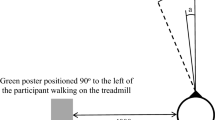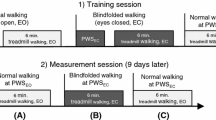Abstract
The main purpose of this study was to investigate the development of the head stabilization in space strategy (HSSS) during various locomotor tasks in 3- to 8-year-old children and adults. The contribution of visual factors to the HSSS was also examined by applying peripheral visual restriction, stroboscopic visual motion cue restriction, and darkness. The kinematics of the head and trunk rotations (pitch, yaw, and roll) were analyzed by means of an optical TV-image processor (ELITE system). For each of the three angular components, an appropriate “head anchoring index” was defined in order to compare the HSSS with a head stabilization on the trunk strategy. Head-trunk correlation rates were also calculated for each angular component in order to evaluate the head-trunk stiffness. The development of head-trunk coordinations during locomotion under normal vision can be said to involve at least three main periods. The first period occurs from the age of 3 to 6 years, when the HSSS is adopted only while walking on the flat ground. While walking on narrow supports, children in this age-group rather tend to increase the head-trunk stiffness, especially at 6 years of age. The second period includes 7- to 8-year-old children. Children of this age become able to adopt the HSSS while walking on narrow supports. During this period, the HSSS is associated with a large decrease in the head-trunk correlations. Lastly, in adulthood the HSSS is commonly adopted but specifically involves the roll component associated with the lateral body oscillations while walking. Vision was found to have little influence on children's HSSS while walking, whatever their age. Moreover, darkness induces an increase in the efficiency of the HSSS in adults. This confirms that the HSSS is the most appropriate strategy available for dealing with an increase in the level of equilibrium difficulty and may reflect a “top-down” organization of the postural control while walking. These results also suggest that the HSSS may be mainly of vestibular origin and presumably serves to facilitate the visual input processing, particularly that of the motion and peripheral visual cues which are involved in the control of body equilibrium during locomotion.
Similar content being viewed by others
References
Amblard B, Carblanc A (1980) Role of foveal and peripheral visual information in maintenance of postural equilibrium in man. Percept Mot Skills 51:903–912
Amblard B, Crémieux J, Marchand AR, Carblanc A (1985) Lateral orientation and stabilization of human stance: static versus dynamic visual cues. Exp Brain Res 61:21–37
André-Thomas (1940) Equilibre et équilibration. Masson, Paris
Assaiante C (1990) Controle visuel de l'équilibre locomoteur chez l'homme: développement et stratégies sensori-motrices. Thesis. C.N.R.S. Marseille, Aix-Marseille II
Assaiante C, Amblard B (1990) Head stabilization in space while walking: effect of visual restriction in children and adults. In: Brandt T, Paulus W, Bles W, Dieterich M, Krafczyk S, Straube A (eds) Disorders of posture and gait. Thieme, Stuttgart, pp 229–232
Assaiante C, Amblard B (1992a) Head-trunk coordination and locomotor equilibrium in 3- to 8-year-old children. In: Berthoz A, Vidal P P, Graf W (eds) The head-neck sensory motor system. Oxford University Press, Oxford, pp 121–125
Assaiante C, Amblard B (1992b) Peripheral vision and age-related differences in dynamic balance. Hum Mov Sci 11:533–548
Assaiante C, Amblard B, Carblanc A (1988) Peripheral vision and dynamic equilibrium control in five to twelve year old children. In: Amblard B, Berthoz A, Clarac F (eds) Posture and gait: development, adaptation and modulation, Elsevier, Amsterdam, pp 75–83
Assaiante C, Marchand AR, Amblard B (1989) Discrete visual samples may control locomotor equilibrium and foot positioning in man. J Mot Behav 21(1): 72–91
Barnes GR, Ranee BH (1974) Transmission of angular acceleration to the head in the seated human subject. Aerosp Med 45:411–416
Bernstein N (1967) The coordination and regulation of movements. Pergamon, Oxford
Berthoz A (1973) Biomechanical and neuromuscular responses to oscillating and transient forces in man and in the cat. In: Jokl E (ed) Medicine and sport, vol 8. Biomechanics III. Karger, Basel, pp 249–260
Berthoz A, Pozzo T (1988) Intermittent head stabilization during postural and locomotory tasks in humans. In: Amblard B, Berthoz A, Clarac F (eds) Posture and gait: development, adaptation and modulation. Elsevier, Amsterdam, pp 189–198
Brandt T, Wenzel D, Dichgans J (1976) Die Entwicklung der visuellen Stabilisation des aufrechten Standes beim Kind: Ein Reifezeichen in der Kinderneurologie. Arch Psychiatr Nervenkr 223:1–13
Brenière Y, Bril B, Fontaine R (1989) Analysis of the transition from upright stance to steady state locomotion in children with under 200 days of autonomous walking. J Mot Behav 21(1): 20–37
Bril B, Brenière Y (1988) Do temporal invariances exist as early as the first six months of independent walking? In: Amblard B, Berthoz A, Clarac F (eds) Posture and gait: development, adaptation and modulation. Elsevier, Amsterdam, pp 23–31
Bronstein AM (1988) Evidence for a vestibular input contributing to dynamic head stabilization in man. Acta Otolaryngol (Stockh) 105:1–6
Crawford J (1952) Living without a balancing mechanism. N Engl J Med 20:458–459
Dutia MB (1988) Interaction between vestibulocollic and cervicocollic reflexes: automatic compensation of reflex gain by muscle afferents. Prog Brain Res 76:173–180
Dutia MB, Hunter MJ (1985) The sagittal vestibulocollic reflex and its interaction with neck proprioceptive afferents in the decerebrate cat. J Physiol (Lond) 359:17–29
Ferrigno G, Pedotti A (1985) ELITE: a digital dedicated hardware system for movement analysis via real-time TV signal processing. IEEE Trans Biomed Eng 32(11): 943–950
Goldberg J, Chimenti J (1989) Head stability during natural postural and locomotor activities. Soc Neurosci Abstr 15(1): 172
Gresty M (1989) Stability of the head in pitch (neck flexion-extension): studies in normal subjects and patients with axial rigidity. Mov Disord 4(3): 233–248
Grossman GE, Leigh RJ (1990) Instability of gaze during locomotion in patients with deficient vestibular function. Ann Neurol 27(5): 528–32
Grossman GE, Leigh RJ, Abel LA, Lanska DJ, Thurston SE (1988) Frequency and velocity of rotational head perturbations during locomotion. Exp Brain Res 70:470–476
Grossman GE, Leigh RJ, Bruce EN, Huebner WP, Lanska DJ (1989) Performance of the human vestibuloocular reflex during locomotion. J Neurophysiol 62(1): 264–272
Guitton D, Kearney RE, Wereley N, Peterson BW (1986) Visual, vestibular and voluntary contributions to human head stabilization. Exp Brain Res 64:59–69
Hatwell Y (1986) Toucher l'espace. Presses Universitaires de Lille, Lille
Hay L (1987) Etude ontogénétique du contrôle d'un mouvement: l'approche manuelle. Thesis. Centre de Documentation CNRS-GLM, Aix-Marseille II (Luminy)
Howard IP (1982) Human Visual orientation. Wiley & Sons, Chichester
Igarashi M, Watanabe T, Maxian PM (1970) Dynamic equilibrium in squirrel monkeys after unilateral and bilateral labyrinthectomy. Acta Otolaryngol (Stockh) 69:247–253
Lund S, Broberg C (1983) Effects of different head positions on postural sway in man induced by a reproducible vestibular error signal. Acta Physiol Scand 117:307–309
Marchand AR, Amblard B (1984) Locomotion in adult cats with early vestibular deprivation: visual cue substitution. Exp Brain Res 54:395–405
Marchand AR, Amblard B, Crémieux J (1988) Early sensory determinants of locomotor speed in adult cats. II. Effects of strobe rearing on vestibular functions. Prog Brain Res 76:229–238
Nashner LM (1985) Strategies for organization of human posture. In: Igarashi M, Black FO (eds) Vestibular and visual control of posture and locomotor equilibrium. Karger, Basel, pp 1–8
Paillard J (1988) Posture and locomotion: old problems and new concepts (foreword). In: Amblard B, Berthoz A, Clarac F (eds) Posture and gait: development, adaptation and modulation. Elsevier, Amsterdam, p VXII
Pedotti A, Crenna P (1988) Multifactorial analysis of voluntary unconstrained movements in man. In: Amblard B, Berthoz A, Clarac F (eds) Posture and gait: development, adaptation and modulation. Elsevier, Amsterdam, pp 167–176
Peterson BW, Bilotto G, Goldberg J, Wilson VJ (1981) Dynamics of vestibulo-ocular, vestibulo-collic and cervico-collic reflexes. Ann NY Acad Sci 374:395–402
Peterson BW, Baker JF, Goldberg J, Banovetz J (1988) Dynamic and kinematic properties of the vestibulocollic and cervicocollic reflexes in the cat. Prog Brain Res 76:163–172
Pozzo T, Berthoz A, Lefort L (1990) Head stabilization during various locomotor tasks in humans. I. Normal subjects. Exp Brain Res 82:97–106
Ripoll H, Bard C, Paillard J (1986) Stabilization of head and eyes on target as a factor in successful basketball shooting. Hum Mov Sci 5:47–58
Roberts TDM (1976) The role of vestibular and neck receptors in locomotion. In: Herman RM, Grillner S, Stein PSG, Stuart DG (eds) Neural control of locomotion. Plenum, New York
Shumway-Cook A, Woollacott M (1985) The growth of stability: postural control from a developmental perspective. J Mot Behav 17(2): 131–147
Sutherland DH, Olshen R, Cooper L, Woo SL (1980) The development of mature gait. Bone Joint Surg 62(3): 336–353
Wilson VJ, Melvill-Jones G (1979) Mammalian vestibular physiology. Plenum, New York
Author information
Authors and Affiliations
Rights and permissions
About this article
Cite this article
Assaiante, C., Amblard, B. Ontogenesis of head stabilization in space during locomotion in children: influence of visual cues. Exp Brain Res 93, 499–515 (1993). https://doi.org/10.1007/BF00229365
Received:
Accepted:
Issue Date:
DOI: https://doi.org/10.1007/BF00229365




